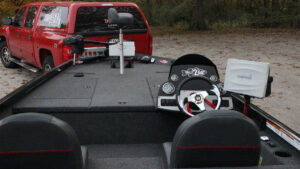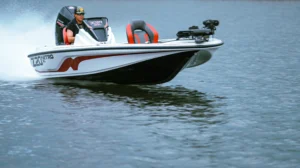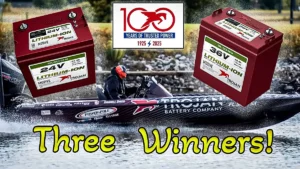I’m routinely asked about the differences between aluminum and fiberglass fishing boats from prospective buyers. Today’s boats are exceptionally well built and the quality of aluminum boats is rapidly catching up to an area that had been home to only fiberglass in years past.
New techniques in boat building on the aluminum side of things has allowed for more rounded edges, more advanced coatings and paint and creature comforts that fiberglass manufacturers had been utilizing for years.
Why aluminum?
In the old days of aluminum, techniques for symmetry, flotation and features were lacking. Aluminum used to be the low-priced spread with wooden decks and lower grade components but that is quickly changing.
Competition among leading brands like Lund, Xpress, G3, Crestliner and Ranger has made that possible. Better ride, level flotation with sound-defeating foam and rough coats for sides and gunnels have changed the game. Better fit and finish plus better materials has also helped.
Boat width is an essential ingredient of today’s new aluminum boats and with width comes stability and a better riding surface. Deck space on today’s aluminums is much more spacious and fishable.
Tighter specifications and the use of tight tolerance jigs and dies in the manufacturing process now has aluminum boats with pad-style running surfaces and better handling ability; both while running and cornering. Component parts are also built with tighter tolerances so the overall ride and feel of most new aluminums is firm and comfortable. Old-style aluminums were narrower and could be tippy and were rougher riding than a brahma bull.
Today’s aluminums are still lightweight but also build to withstand the pounding of big lakes and rivers. Intricate stringer and support systems are styled off of their fiberglass cousins and are built to be quiet and take a pounding on most models. High-performance aluminum boats can be built and are sporting up to 250-horsepower outboards with jackplates and shallow-water anchors on the transom.
Depending on the type of bottom you are looking for, V-Hull or bass boat-style will allow the purchaser to pick big water rides most suitable to the style of fishing they do most often.
Aluminum buyers have a lot of choices and the type and size of the fishery most visited should be taken into account. Buying aluminum doesn’t mean you are getting less of a boat. Long-lasting paint schemes makes this “new” affordable aluminum a great purchase for both the family and tournament pro.
They also have inshore, hunting and mid-range level boat packages that can stand up to on-the-water activity. Duck hunters have known for years just how good aluminum boats handle even the toughest of conditions and with tiller steering.
Costs of the new aluminum boats are creeping up a bit in recent years as more features and amenities are added but they are still less expensive compared to fiberglass based on an apples-to-apples comparison.
Why fiberglass?
Fiberglass boats have been the go-to boats for tournament anglers for years. Some of that is based on performance attributes but can also be as a result of pro tournaments and pro angler endorsement as well.
Fiberglass is a flexible and strong material that can be formed by the use of a mold to build boats. It has been a mainstay in high-performance fishing boats since the late 60s and continues to improve. Better resins and woven—the matting used for strength—is engineered specifically for boats today. Better hull designs—the running surface of the boats—have also become much better with carefully designed strakes and chine contours for both more speed and stability, even at high speeds. Reverse chines on some models actually push the water away from the boat allowing for a cleaner planing capability.
In the early days, the technology of forming fiberglass came out of the automotive field and was migrated to boat building. Specific resins combined with the woven varies by manufacturer and each one has a different process for building their boats. Automation has made each boat more standardized by weight and dimension and flex points have been strengthened with new composite materials like multi-layer fiberglass blocks and other materials that provide strength but also will not absorb water like wood in older models. Many new boats even have fiberglass transoms.
Typically in fiberglass boats, there are no sharp edges inside or along the gunnels. Slick finishes can be customized to just about every color in the rainbow and gel coats that protect those finishes continue to evolve too. A properly maintained fiberglass boat can look like new even after years of use if sealed with a good fiberglass sealer. Many anglers do not know that even the best clear can be porous and dirt can harm the finish. A good cleaner followed with a sealer can eliminate oxidation and fading.
Fiberglass models like Ranger, Nitro, Bass Cat and Phoenix continue to listen to their pros and customers and one of the last bastions of conquest is the inside of the gunnels of the boat. Modular tackle storage, better rod boxes and even ventilation systems are add-ons in recent years.
Fiberglass options will, on average, cost more too.
What material is best for me?
A good rule of thumb for purchase is dividing the cost into how many times you get to go fishing. That quick formula will help determine what type of boat is best for you. Two things happen with this approach: It balances the time on the water with the amount of money it takes to get on it and it gives you and excuse to go fishing more to justify the cost.
I recommend you buy as much boat as you can afford if money is an issue. Nothing is worse than buying a boat and not having the budget to use it. With that said, I suggest getting as much trolling motor, electronics and the best batteries you can afford with the purchase no matter what material your boat is made from.
Buying a boat is a major purchase. Do your research and don’t just look at how it looks but rather look at how it functions for your type of fishing. You will be glad you did.















